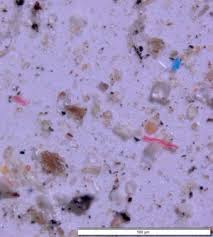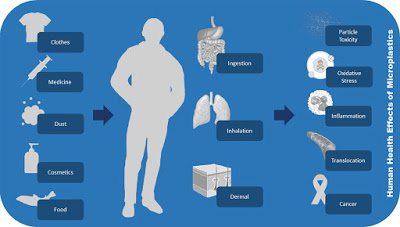And We Thought Pandemics Were Bad...Time to Examine The Threat from Microplastics
 Kim BellardThose of us of a certain age, or anyone who loves classic movies, remember the famous scene in "The Graduate" when Benjamin Braddock is given what is intended as a helpful clue about the future. "Plastics," one of his father's friends says. "There's a great future in plastics."
Kim BellardThose of us of a certain age, or anyone who loves classic movies, remember the famous scene in "The Graduate" when Benjamin Braddock is given what is intended as a helpful clue about the future. "Plastics," one of his father's friends says. "There's a great future in plastics."
Well, we're living in that future, and it's not all that rosy. Plastics have, indeed, become an integral part of our world, giving billions of us products that we could never otherwise have or afford. But our future is going to increasingly be driven by an unintended consequence of the plastics revolution: microplastics.
And that's not good.
Microplastics are what happens to plastic after it has gone through the wringer, so to speak. Plastic doesn't typically decompose, at least not in any time frame we're capable of grasping, but it does get broken down into finer and finer particles, until they reach microscopic levels (thus "microplastics"). We've known for some time that plastics were filling our landfills, getting caught in our trees and bushes, washing up on our shorelines, even collecting in huge "garbage patches" in the ocean. But it wasn't until more recently that we've found that plastics' reach is much, much broader than we realized, or could see. Microscopic fragments in rain-Credit Janice BrahneyThe ocean full of microplastics, and fish are as well. They're in our drinking water. Indeed, "There's no nook or cranny on the surface of the earth that won't have microplastics," Professor Janice Brahney told The New York Times. Dr. Brahney was coauthor on a recent study that found microplastics were pervasive even in supposedly pristine parts of the Western U.S. They estimated that 1,000 tons of "plastic rain" falls every year onto protected areas there; 98% of soil samples they took had microplastics. Dr. Brahney pointed out that, because the particles are both airborne and fine, "we're breathing it, too."
Microscopic fragments in rain-Credit Janice BrahneyThe ocean full of microplastics, and fish are as well. They're in our drinking water. Indeed, "There's no nook or cranny on the surface of the earth that won't have microplastics," Professor Janice Brahney told The New York Times. Dr. Brahney was coauthor on a recent study that found microplastics were pervasive even in supposedly pristine parts of the Western U.S. They estimated that 1,000 tons of "plastic rain" falls every year onto protected areas there; 98% of soil samples they took had microplastics. Dr. Brahney pointed out that, because the particles are both airborne and fine, "we're breathing it, too."
She admitted: "It's really unnerving to think about it."
This troubling study is only one of several recent related studies. A study in early June found microplastics circulating even on deep sea floors. Another study took samples from microscopic creatures on King George Island, isolated between Antarctica and the tip of South America. "If microplastics can enter the food web here, they can probably do so almost anywhere on earth," wrote coauthor Tancredi Caruso. "But this is exactly what colleagues and I discovered."
The authors believe: "there is a very high risk that they have already deeply penetrated the soil food web, potentially with negative impacts on the interactions between plants and soil."
If you're still not convinced, Fast Company reports on two studies that found microplastics are being absorbed by roots of plants, ending up in the fruits and vegetables we eat. Microplastics were found in apples, broccoli, carrots, lettuce, pears, potatoes, and wheat. Fruits seem to have more than vegetables, possibly due to their trees' larger root system. One of the researchers, Professor Willie Peijnenburg of Leiden University, said that, even ignoring the health risks, "simply, most people don't like to be eating plastics."
Yet we are.
 Microplastics in the ecosystem-Credit Wu, et. al./Science DirectLast but not least, another recent paper Microplastics in Terrestrial Ecosystems, stressed the need to look at the broad impacts of microplastics on the entire ecosystem. For example: "Deposition and accumulation of microplastics can affect soil properties, with consequences for process rates and net primary production (NPP), causing feedbacks to the atmosphere, including greenhouse gases (GHGs). So far, nanoplastic has unknown consequences for this system." They may also alter water flow in soil and rate of erosion. The authors conclude: "Feedbacks to the Earth system can be expected...Microplastic pollution is an international problem."
Microplastics in the ecosystem-Credit Wu, et. al./Science DirectLast but not least, another recent paper Microplastics in Terrestrial Ecosystems, stressed the need to look at the broad impacts of microplastics on the entire ecosystem. For example: "Deposition and accumulation of microplastics can affect soil properties, with consequences for process rates and net primary production (NPP), causing feedbacks to the atmosphere, including greenhouse gases (GHGs). So far, nanoplastic has unknown consequences for this system." They may also alter water flow in soil and rate of erosion. The authors conclude: "Feedbacks to the Earth system can be expected...Microplastic pollution is an international problem."
The trouble is we just don't know what the impacts of microplastics are on our health. Some particles may have harmful chemicals and pollutants, most are largely carbon, but few natural systems, including our bodies, can break them down. We may excrete many of the particles we get, but we get a lot. One study warned:
In all biological systems, microplastic exposure may cause particle toxicity, with oxidative stress, inflammatory lesions and increased uptake or translocation. The inability of the immune system to remove synthetic particles may lead to chronic inflammation and increase risk of neoplasia. Furthermore, microplastics may release their constituents, adsorbed contaminants and pathogenic organisms
The same is happening to our entire food chain, as well as to our atmosphere, soil, and water, and it's largely an accumulative process. As Dr. Brahney noted to The Washington Post, " We are producing something that doesn't go away, and just because we can't see it doesn't mean it's not there.
 Human health effects of microplastics-Credit Prata, et. al./Science Direct"We know that lead is bad for us, such as in our drinking water. We've identified many carcinogens, such as asbestos or dioxin, to which we're trying to reduce our exposure. We understand that air pollution is bad for us. But we haven't gotten our heads around the fact that remnants of all those plastic water bottles, to name one common source, are literally everywhere, down to the cellular level. And we don't really have any idea what it is doing to us, our food supply, or the planet on which we live.
Human health effects of microplastics-Credit Prata, et. al./Science Direct"We know that lead is bad for us, such as in our drinking water. We've identified many carcinogens, such as asbestos or dioxin, to which we're trying to reduce our exposure. We understand that air pollution is bad for us. But we haven't gotten our heads around the fact that remnants of all those plastic water bottles, to name one common source, are literally everywhere, down to the cellular level. And we don't really have any idea what it is doing to us, our food supply, or the planet on which we live.
"Microplastics are now considered an emerging food safety concern, but we really don't have all the answers yet," microbiologist Dave Love told Discover earlier this year. Dr. Love admits, "At the end of the day, there's not a clear consensus yet on what the advice should be for consumers."
Prata, et. alia urged:
Nonetheless, knowledge on microplastic toxicity is still limited and largely influenced by exposure concentration, particle properties, adsorbed contaminants, tissues involved and individual susceptibility, requiring further research.
Everyone agrees more research is necessary, but meanwhile, we keep producing more plastics, which end up, well, everywhere, at every size, right down to nanoparticles. It doesn't take a microbiologist to realize that is not good, and is certainly going to get worse.
Right now, the world is (understandably) preoccupied with another microscopic object, the coronavirus. COVID-19 is infecting tens of millions of worldwide and killing hundreds of thousands. It would be ironic if microplastics prove to be the greater threat to us, the world, and everything in it.
This article was authored by Kim Bellard and first published in his blog, From a Different Perspective.... It is reprinted by Open Health News with permission from the author. The original post can be found here.
- Login to post comments